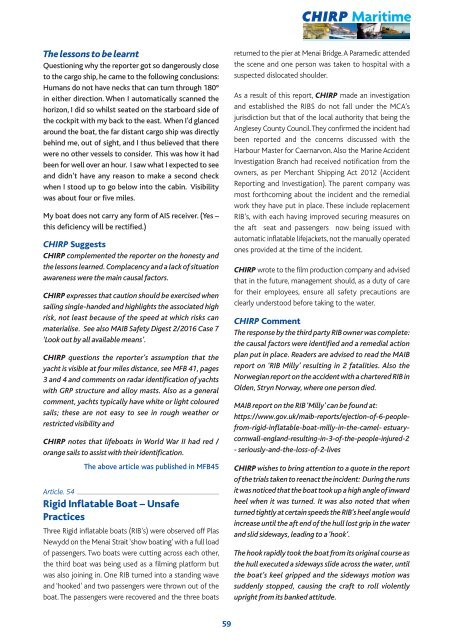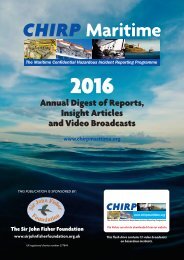CHIRP annual digest 2016 6th
Create successful ePaper yourself
Turn your PDF publications into a flip-book with our unique Google optimized e-Paper software.
<strong>CHIRP</strong> Maritime<br />
The lessons to be learnt<br />
Questioning why the reporter got so dangerously close<br />
to the cargo ship, he came to the following conclusions:<br />
Humans do not have necks that can turn through 180°<br />
in either direction. When I automatically scanned the<br />
horizon, I did so whilst seated on the starboard side of<br />
the cockpit with my back to the east. When I’d glanced<br />
around the boat, the far distant cargo ship was directly<br />
behind me, out of sight, and I thus believed that there<br />
were no other vessels to consider. This was how it had<br />
been for well over an hour. I saw what I expected to see<br />
and didn’t have any reason to make a second check<br />
when I stood up to go below into the cabin. Visibility<br />
was about four or five miles.<br />
My boat does not carry any form of AIS receiver. (Yes –<br />
this deficiency will be rectified.)<br />
<strong>CHIRP</strong> Suggests<br />
<strong>CHIRP</strong> complemented the reporter on the honesty and<br />
the lessons learned. Complacency and a lack of situation<br />
awareness were the main causal factors.<br />
<strong>CHIRP</strong> expresses that caution should be exercised when<br />
sailing single-handed and highlights the associated high<br />
risk, not least because of the speed at which risks can<br />
materialise. See also MAIB Safety Digest 2/<strong>2016</strong> Case 7<br />
‘Look out by all available means’.<br />
<strong>CHIRP</strong> questions the reporter’s assumption that the<br />
yacht is visible at four miles distance, see MFB 41, pages<br />
3 and 4 and comments on radar identification of yachts<br />
with GRP structure and alloy masts. Also as a general<br />
com ment, yachts typically have white or light coloured<br />
sails; these are not easy to see in rough weather or<br />
restricted visibility and<br />
<strong>CHIRP</strong> notes that lifeboats in World War II had red /<br />
orange sails to assist with their identification.<br />
The above article was published in MFB45<br />
Article. 54<br />
Rigid Inflatable Boat – Unsafe<br />
Practices<br />
Three Rigid inflatable boats (RIB’s) were observed off Plas<br />
Newydd on the Menai Strait ‘show boating’ with a full load<br />
of passengers. Two boats were cutting across each other,<br />
the third boat was being used as a filming platform but<br />
was also joining in. One RIB turned into a standing wave<br />
and ‘hooked’ and two passengers were thrown out of the<br />
boat. The passengers were recovered and the three boats<br />
returned to the pier at Menai Bridge. A Paramedic attended<br />
the scene and one person was taken to hospital with a<br />
suspected dislocated shoulder.<br />
As a result of this report, <strong>CHIRP</strong> made an investigation<br />
and established the RIBS do not fall under the MCA’s<br />
jurisdiction but that of the local authority that being the<br />
Anglesey County Council. They confirmed the incident had<br />
been reported and the concerns discussed with the<br />
Harbour Master for Caernarvon. Also the Marine Accident<br />
Investigation Branch had received notification from the<br />
owners, as per Merchant Shipping Act 2012 (Accident<br />
Reporting and Investigation). The parent company was<br />
most forthcoming about the incident and the remedial<br />
work they have put in place. These include replacement<br />
RIB’s, with each having improved securing measures on<br />
the aft seat and passengers now being issued with<br />
automatic inflatable lifejackets, not the manually operated<br />
ones provided at the time of the incident.<br />
<strong>CHIRP</strong> wrote to the film production company and advised<br />
that in the future, management should, as a duty of care<br />
for their employees, ensure all safety precautions are<br />
clearly understood before taking to the water.<br />
<strong>CHIRP</strong> Comment<br />
The response by the third party RIB owner was complete:<br />
the causal factors were identified and a remedial action<br />
plan put in place. Readers are advised to read the MAIB<br />
report on ‘RIB Milly’ resulting in 2 fatalities. Also the<br />
Norwegian report on the accident with a chartered RIB in<br />
Olden, Stryn Norway, where one person died.<br />
MAIB report on the RIB ‘Milly’ can be found at:<br />
https://www.gov.uk/maib-reports/ejection-of-6-peoplefrom-rigid-inflatable-boat-milly-in-the-camel-<br />
estuarycornwall-england-resulting-in-3-of-the-people-injured-2<br />
- seriously-and-the-loss-of-2-lives<br />
<strong>CHIRP</strong> wishes to bring attention to a quote in the report<br />
of the trials taken to reenact the incident: During the runs<br />
it was noticed that the boat took up a high angle of inward<br />
heel when it was turned. It was also noted that when<br />
turned tightly at certain speeds the RIB’s heel angle would<br />
increase until the aft end of the hull lost grip in the water<br />
and slid sideways, leading to a ‘hook’.<br />
The hook rapidly took the boat from its original course as<br />
the hull executed a sideways slide across the water, until<br />
the boat’s keel gripped and the sideways motion was<br />
suddenly stopped, causing the craft to roll violently<br />
upright from its banked attitude.<br />
59



